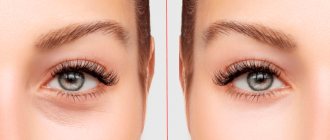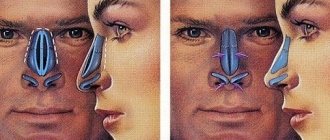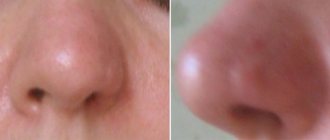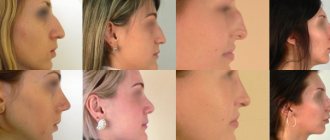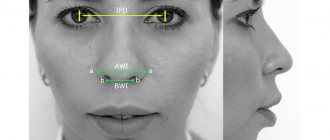Rhinoplasty is an operation to reconstruct or straighten the nose. It is considered one of the most popular plastic surgeries in the world.
Rhinoplasty in Korea means the use of the most modern surgical equipment, micro-instruments, lasers, endoscopes, as well as a high level of qualifications of specialists.
Rhinoplasty in Korea is aimed not only at the aesthetic, but also at the functional component: patients gain a beautiful nose and free breathing.
Contraindications for rhinoplasty in Korea: acute infectious diseases, oncology, diabetes, bleeding disorders.
Korean experts also recommend performing a similar operation for patients over 16 years of age. At this age, the nasal bones are already fully formed, which means that the operation will be performed with a minimum of complications.
How much does blepharoplasty cost in Korea?
Many people, and this is especially true for the female half of the population, with the appearance of wrinkles or the presence of any defects around the eyes, strive to improve the condition of their skin by applying new methods for correcting the upper and lower eyelids. Today, this technique is called blepharoplasty, when, through small incisions, the skin of the eyelids is tightened, excess fat is removed, and the woman looks young and fresh again. However, like many plastic surgeries, blepharoplasty is an expensive procedure. But we cooperate with Korean clinics that can provide different prices for clients, taking into account their financial capabilities. And this article provides tabular data about the different types of blepharoplasty, where you can find out how much blepharoplasty costs in Korea .
Nose job
Rhinoplasty can no longer surprise anyone, so the Koreans moved on. At the peak of popularity is surgery to reduce the nostrils. Usually, Korean women raise the bridge of their nose along with it. As a result, only memories remain of the flattened Asian nose. And a long three-month rehabilitation.
You understand that a beauty contest in Korea is more of a battle of plastic surgeons. By the way, about 20% of plastic surgeons’ patients in Korea are men. So the question of striving for an ideal appearance is a sore subject for both the weaker sex and the stronger.
UPPER EYELID PLASTY
Upper eyelid blepharoplasty is often prescribed to patients when there are deep wrinkles around the eyes, drooping outer corners of the eyes, and congenital or acquired defects. After the patient undergoes a preliminary examination of the body, the doctor decides whether such an operation can be performed.
Contraindications to this procedure are:
- diabetes;
- high intraocular pressure;
- poor blood clotting;
- arterial hypertension;
- malignant formations in the body;
- diseases of the cardiovascular system.
Progress of the operation
The duration of the operation is 30 minutes (rarely more than this time).
1. The surgeon marks the incision lines on the face and takes the patient to the operating room.
2. Anesthesia is given and after a while the surgeon begins to make incisions.
3. Excess skin and folds are removed.
4. The specialist penetrates deep into the skin to remove the orbicularis muscles. Then the seam will look natural.
5. Working with fatty tissue above the eye, which can hang over time.
6. If necessary, fiber is removed in the center and corners of the eye.
7. The surgeon sews up the incisions.
Droopy eyelids
Bags under the eyes make you look older, and dark circles make you look tired. This procedure can remove dark circles or lift bags under the eyes that have formed with age.
Removal of transconjunctival orbital fat
Prominent lower fat pads give a tired appearance and make you look older than your age, even if there are no wrinkles or sagging skin. This method will help remove excess fatty tissue through the inside of the eyelid without leaving scars.
Who is this procedure suitable for?
- You have a slight bulge under your lower eyelid
- You have dark circles under your eyes
Description of the procedure
Using an incision on the inner surface of the lower eyelid (conjunctiva), you can gain access to the pocket of orbital tissue. After opening this pocket, fat is removed. The cut areas are then adjusted.
VARIETIES OF UPPER EYELID PLASTY
Seamless technique . It is excluded for those who have severely stretched skin, but is applicable to solve other problems with the upper eyelid. The operation lasts 90 minutes. A scalpel or laser is used. The patient can be discharged on the same day 7 hours after surgery.
Laser technique . Indicated for drooping eyelids, age-related changes, excess fat and skin. The laser makes an incision along natural lines, penetrating deep into the skin, which may cause slight pain. The specialist performs a tightening, working with muscle tissue.
The main advantages of this technique are the elimination of scars and the appearance of bruises and swelling, rapid healing of wounds, effect up to 10 years, discharge from the hospital 4 hours after surgery.
Transconjunctival method . An incision is made from the inside of the eyelid, where an endoscope is inserted and the operation is performed under local anesthesia. Duration from 1.5 hours. Implants can be used to ensure long-lasting effects.
Non-surgical technique . Its advantages are maximum safety for patients, low morbidity, complications and rehabilitation after surgery are excluded. Conducted in an outpatient setting.
Popular non-surgical procedures include: thermolifting, mesothreads, injection lifting, thermage and ultrasonic smas lifting.
Pinch technique . Pinch radiolifting, when the surgeon uses a device with a special ampoule containing electrodes. Radio waves penetrate deeply into the layers of the epidermis, causing natural collagen production. As a result, the skin is tightened, and the effect lasts up to 4 years.
Results of upper eyelid surgery
The operation can be repeated 7-10 years after the first blepharoplasty. If a relapse occurs after the operation, the eyelids turn out due to a scar defect, or there is a need to correct the palpebral fissures, the procedure is repeated earlier.
Ptosis correction
Weakness of the eye opener muscle (levator muscle) can cause the eyelid to droop and often give a sleepy appearance. Many people who have this problem tend to use their eyebrow muscles to open their eyes, thereby creating additional wrinkles and headaches. This procedure will strengthen the eye opener muscle for easier eye opening and more expressive eyes.
Who is this procedure suitable for?
- You look sleepy/tired
- You have slight changes after double eyelid surgery
- You have asymmetrical eyelids (drooping, high folds, sunken eyes)
- You have a symptom of drooping eyelids
*For patients with severely drooping eyelids, only the incisional method (surgical) is optimal.
Description of the procedure
1) Incisional method
This method is also performed as incisional double eyelid surgery. Additionally, the opening muscle is tightened
and the strength of the eye opening function returns.
2) Non-incisional method This method is intended for people with minimal to moderate drooping eyelids who do not want to do a double fold or are afraid of incisions. For clients wishing to undergo a double fold, the procedure can be combined with non-incisional double eyelid surgery. The opening muscles are tightened with a thread on the inner surface of the eyelids.
LOWER EYELID PLASTY
Lower eyelid correction is often used in cases where it is necessary to remove bags under the eyes, swelling, wrinkles, ptosis (drooping of one or both eyelids), eye asymmetry, and also change a person’s look.
Advantages . There are no age restrictions, in some cases it improves peripheral vision and stabilizes intraocular pressure. Popular among women who want to make their face look younger. Can be combined with other plastic procedures.
Indications and contraindications . They are similar to those provided for upper eyelid blepharoplasty. In any case, a full examination and consultation with a specialist is necessary before the procedure.
Preparation and progress of the operation
2 weeks before surgery you need to stop visiting the solarium, beaches, drinking alcohol and smoking. Avoid any drugs that affect blood clotting.
The duration of the operation is from 20-30 minutes to 1.5-2 hours, depending on the technique.
In terms of complexity of the operation and detail, it differs from upper eyelid plastic surgery.
1. Anesthesia is applied.
2. The surgeon makes an incision just below the growth of the eyelashes, about 2 mm to the outer corner of the eye. From there it makes a slight downward turn. Thus, the periocular muscles are dissected and a piece of skin is separated so that fat hernias can be easily removed or redistributed, as well as tightened the muscles.
3. Stitching.
Lower eyelid surgery techniques
All techniques are identical to those used for upper eyelid blepharoplasty. They can be found in the section on upper eyelid surgery .
The effect after lower eyelid surgery is up to 9-10 years. For residents of megacities, this period is reduced to 5-6 years due to special living conditions (stress, environment, etc.).
Rehabilitation
Depending on the technique used, the patient will stay in the clinic or go home a few hours later. There is no recovery period after the non-surgical method. If there was laser plastic surgery, the swelling will begin to go away in 3-4 days. Classic blepharoplasty allows up to 21 days for recovery.
In the first days after surgery, physical activity is contraindicated to prevent blood pressure from rising. Makeup is prohibited for up to 7 days. It is recommended to apply cold compresses to help swelling go away faster, as well as ointments for pain relief and wound healing.
Possible complications
In this case, there are early and late complications. Early symptoms include bleeding, swelling and inversion of the lower eyelid, which appear immediately or a few days after surgery. If the situation does not change after a week, you should consult a doctor.
After the rehabilitation period, late complications . These include: displaced lacrimal openings and tearing that can occur after swelling, suture dehiscence, a cyst that has arisen at the suture site, as well as the appearance of a “hot eye” effect if the patient performs one operation after another without taking a break and without undergoing rehabilitation. Headaches and hematomas are not excluded. In any case, observation by the attending physician is necessary.
Chin surgery
The standard of beauty in Korea is a small face with a V-shaped, sharp chin. The favorite gestures of young Korean women is to place their chin in their hands joined at the wrists. It sounds too cute, but it is a metaphor for a flower, where the face is the bud and the palms are the petals. So, the bud should not be in the shape of a ball.
Chin surgery is considered one of the most dangerous. During the operation, the bone is literally crushed and then reassembled. Swelling and pain are a common occurrence for patients who have undergone chin surgery. But this doesn’t stop the beauties: they are ready to spend six months on rehabilitation just to get the face of their dreams.
For those who do not want to change the shape of their chin, but want to make it smaller, there is jaw reduction surgery. The surgeon will not break the bone, but will simply saw off the “extra” part. You can reduce your jaw in just 6 hours, and another 3 weeks will be spent on rehabilitation.
ASIAN EYE PLASTY
Today, the congenital shape of Asian eyes can be changed to a more open one and made similar to a European one thanks to blepharoplasty. During the operation, the surgeon creates a fold in the lower eyelid area and removes the overhanging fold in the upper eyelid. Often the indication for such an operation is the patient’s wishes. Local or general anesthesia with sedatives is used. The results usually last for the rest of your life.
Contraindications
- infections, diseases in the acute stage;
- menstruation in women;
- blood diseases;
- diabetes;
- diseases of the endocrine system;
- malignant tumors;
- dry eye syndrome;
- arterial, intracranial and intraocular hypertension;
- excessive bags under the lower eyelids, swelling, which can spoil the outcome of the operation.
4 types of Asian eye surgery
1. Natural correction, when a furrow is made on the upper eyelid, which then gradually turns into a fold at the inner corner of the eye.
2. The formation of the furrow occurs parallel to the contour of the eye when a small gap is formed between the epicanthus and the new fold.
3. A semilunar shape of the groove is made, and the fold of the eyelid is raised a short distance above the central part of the eye. The look of such eyes becomes slightly naive or surprised.
4. The fourth option is used for older people. The outer corner of the eye is raised and the same technique is used to create a parallel fold. The difference is that the shape of the fold harmoniously rises to the top of the outer corner of the eye.
Plastic surgery techniques for Asian eyes
A technique with a full eyelid incision and correction without an incision are used.
Method with an incision
1. An incision is made in the congenital fold of the upper eyelid, which runs along the line where the eyelashes grow and in the area of 5-10 mm above the edge. A double supraorbital fold is formed.
2. Removal of excess skin and fatty tissue of the upper eyelid.
3. The edges of the incisions are sutured in layers.
4. All threads are fixed and sutures are applied.
5. If necessary, a fold of skin at the inner corner of the eye is removed.
Method without incision
It is used for those whose upper eyelid skin is too thin or whose Asian eye shape is not so pronounced.
An incision of up to 1 mm is made from inside the upper eyelid. A double supraorbital fold is formed. Next, the surgeon stitches the tissue layer by layer between the skin and the tendon of the upper eyelid muscle. The fold becomes stronger. Sutures are applied with thin punctures.
Recovery after surgery
Duration – up to 14 days. During this period, you must adhere to all doctor’s recommendations, including:
- do not wear contact lenses;
- exclude decorative cosmetics;
- avoid direct rays of the sun, going outside only in the evening; wear glasses during the day;
- instill eye drops so that the eyes do not dry out, do not get infected, and heal faster;
- exclude reading books and using a computer;
- do not drink alcohol;
- avoid strenuous physical activity.
The swelling that usually appears after surgery will go away within 2 weeks. You can apply ice.
Complications that go away over time:
- tearfulness;
- dry eyes;
- inflammatory processes;
- burning in the mucous membrane;
- dehiscence of sutures or postoperative scars;
- deformation of the cartilage of the upper eyelid, eversion.
Epicanthus plastic surgery
Medial (midline) epicanthus plastic surgery
Changing the shape of the eye. The skin of the epicanthus (Mongoloid fold) is incised and adjusted, resulting in larger and more expressive eyes.
Who is this procedure suitable for?
- You have a Mongoloid fold (epicanthus)
- You have a high inner fold
- You have a large distance between your eyes
- The inner corners of your eyes droop downwards
- Do you want to enlarge your eyes?
Description of the procedure
The epicanthus fold is removed. The remaining skin is adjusted and shaped into the desired shape and angle. The seams are hidden along the new line of the corner of the eye.
Lateral (side) epicanthus plastic surgery
Changing the shape of the outer (lateral) corner of the eye to enlarge and give expressiveness to the eyes. The procedure is performed by changing the lateral epicanthus. This operation can also change the angle of the eye. The shape and angle of your eye is individually adjusted by experienced surgeons to ensure the best results.
Who is this procedure suitable for?
- Do you want to enhance your eye shape?
- The inner corner of your eye looks up
- Your eyes are too close for medial plastic surgery
- You have a strong, fierce look
Description of the procedure The outer skin around the eyes is opened and the mucous membrane is transferred to the desired position under the skin. Stitches are used to hold the shape in place.
Patient reviews of blepharoplasty in Korea
Ali: “When I came from Kyrgyzstan to live in Moscow, I immediately realized that I stood out because of my eyes. As a man, I understood that plastic surgery is mostly done by women and it is not for me. But, as a person, he wanted to be like everyone else. Therefore, not immediately, but I decided to have an operation to change the shape of my eyes. We recommended one of the clinics in Korea here on the website. That's where I went. I was very worried that I might lose my sight. However, apart from a little pain during the procedure, I survived everything normally. 2 weeks after the operation, the bruises disappeared, I kept using special eye drops on the doctor’s advice. Gradually, I began not only to get used to the new look, but also to enjoy the new face and feel confident in communicating with people.”
Natalie: “I, like any woman, want to look younger and more interesting. Although with caution, I decided to change the upper eyelids of my eyes to make them more expressive. On the advice of friends and after consultation with local ophthalmologists, I turned to plastic surgery specialists in Korea through the website koreamedexpress.ru. They helped me find a good clinic, where I had the operation. Of course, the sensations after the procedure are terrible, swelling lasts for 2 days, and your face looks like a ball after being stung by hundreds of bees. When going outside, she put dark glasses on half her face. However, after a couple of weeks, my face began to return to normal, and after a while I saw the beauty in the mirror! I realized that beauty is really worth the sacrifice!”
